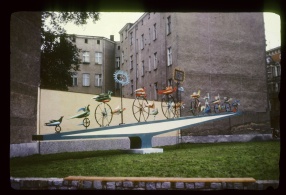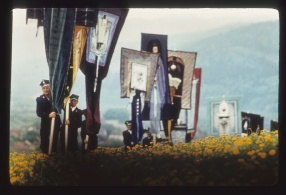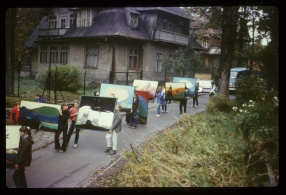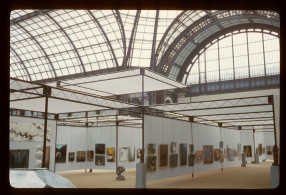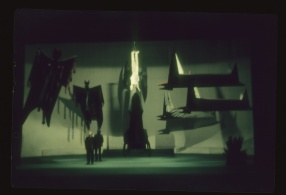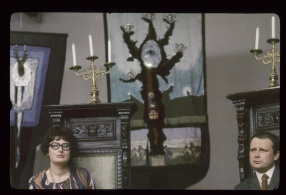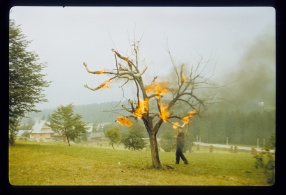Władysław Hasior's Art
Władysław Hasior's art turned out to be a cultural phenomenon in Poland already in the first half of 1960s, first of all, due to exploration within sacrum and use of exceptional materials: soap, reinforced cement, to build expression. Hasior had exhibitions actually almost in every municipal gallery in Poland and was one of the most often presented Polish creators abroad. His art was very popular with ones and never gained any respect among others (e.g. Tadeusz Kantor). Eminent art experts and critics as well as publicists of these times, e.g. Anna Micińska, Jerzy Stajuda, Janina Ładnowska, Antoni Dzieduszycki, Janusz Bogucki, Aleksander Jackowski or Wiktor Osiatyński wrote about him. The most important Polish curators, e.g. Ryszard Stanisławski, at the "Metaphors" exhibition in the Sopot Art Exhibition Office in 1962, and Marek Rostworowski, at the "Romance and Romanticism" exhibition in Warsaw Zachęta in 1975, showed his works.
They were interested in uniqueness of this art, its material commitment as well as lightness of anecdote and narration from beyond the existing division into academic art and avant-garde. Hasior, in his golden period, felt very well a bit of contemporaneity combining it with wartime experiences of his generation. Hence, the weight of concrete, soap and fire in his art, hence, the will of creating monumental narrations bearing witness to appalling experience. In the 70s., tension is gradually diluted and accents are moved to commonness, plebeianism, anecdote, itemisation of conceptual shortcut between the metaphor of the title and the matter of the work: "It means that a new manner of representation must be found for old concepts, thus the punch-line of my «Zwiastowanie» ["Annunciation"] is not an angel announcing a piece of news but a burning telephone incorporated in the image. In the times in which we are living we receive burning information just by phone" (a quotation from Hasior, after: "Myśli o sztuce" ["Thoughts on Art"], Nowy Sącz 1987).
The most important monographic studies on Władysław Hasior's art include: erudite and personal monograph by Andrzej Banach of 1964, similar work by Anna Micińska, expert on Zakopane, academic concepts (in particular, calendars and reconstructions of facts) by Józef Chrobak (2014) and Monika Szczygieł-Gajewska (2011) and a work reinterpreting a discourse on the "Konferecja tatrzańska" ["Tatra Conference"] assemblage (2015). The other works are important documents from this era.
The set includes "Notatniki" ["Notebooks"]: "Pomniki" ["Monuments"] (204, 231), "Genua, Buenos Aires, Montevideo" (086), "Szklane pomniki" ["Glass Monuments"] (205), "Pomniki i ptaki" ["Monuments and Birds"] (202), "Ptaki Koszalin" ["Birds - Koszalin"] (172, 173), "Ptaki Władysława Hasiora" ["Birds of Władysław Hasior"] (279), "Ptaki Szczecin" ["Birds - Szczecin"] (312), "Ogniste ptaki" ["Fire Birds"] (004), "Konie" ["Horses"] (174, 201), "Słoneczny rydwan" ["Sunny Chariot"] (253, 278), "Anioły szwedzkie" ["Swedish Angels"] (178, 198, 233), "Pomniki, sztandary" ["Monuments, Banners"] (006), "Sztandary" ["Banners"] (177: 1 and 2, 200, 238), "Sztandary i plakaty" ["Banners and Posters"] (242), "Portret imaginacyjny" ["Imaginary Portrait"] (001, 171), "Miniatury" ["Miniatures"] (002, 176, 185), "Miniatury, chleb, maszyna" ["Miniatures, Bread, Machine"] (187), "Kapliczki domowe" ["Home Chapels"] (186, 232), "Totemy" ["Totems"] (188), "Obiekty" ["Objects"] (170, 192), "Wózek" ["Pram"] (196), "Wózek i Wyszywanie charakteru" ["Pram and Embroidery of Character"] (222), „Obrazopodobne” ["Image-Like"] (195, 236), "Ptaki montaże" ["Birds - Assemblies"] (225), "Montaże" ["Assemblies"] (234), "Miniatury montaże" ["Miniatures - Assemblies"] (235), "Montaze obrazopodobne" ["Assemblies - Image-Like"] (240, 241), "Montaze bardzo pilne" ["Assemblies - Highly Urgent"] (361), "Anioły Szwedzkie" ["Swedish Angels"] (198), "Projekty aniołów szwedzkich" ["Designs of Swedish Angels"] (178, 233), "Przeprowadzka" ["Move"] (193, 224), "Wystawy" ["Exhibitions"] (191), "Wystawy, pracownie" ["Exhibitions, Workshops"] (197), "Wnętrza" ["Interiors"] (239, 321), "Instalacje" ["Installations"] (262), "Fragmenty ekspozycji" ["Fragments of Exhibition"] (257, 258), "Przedstawienie teatralne" ["Theatrical Performance"] (316), "Scenografia" ["Stage Designing"] (194), "Film TV" ["TV Movie"] (003), "TV" (175), "Dokumentacja prac Władysława Hasiora z filmu 1963" ["Documentations of Władysław Hasior's Works from the Movie of 1963"] (309), "Film ścinki" ["Movie - Offcuts"] (368), "Koła solarne" ["Solar Circles"] (226), "Strącenie aniołów" ["Casting-Down of Angels"] (223), "Obiekty Jazowsko" ["Objects - Jazowisko"] (190), "Płonące anioły" ["Burning Angels"] (221), "Ostatni koncert" ["Last Concert"] (227), "Płonące drzewo" ["Burning Tree"] (230), "Foto Gozdan" ["Photo Gozdan"] (199), "Dokumentacja projektów" ["Documentation of Designs"] (228), "Prace Władysława Hasiora" ["Władysław Hasior's Works"] (254, 276, 277, 371), "Złe zdjęcia" ["Bad Photographs"] (343).
General selected bibliography:
"Hasior Powrót" ["Hasior Comeback"], ed. M. Raińska, exhibition catalogue, MCK Sokół, Nowy Sącz 2011.
"Hasior Powrót" ["Hasior Comeback"] (post-conference materials), ed. M. Raińska, Nowy Sącz 2011.
M. Szczygieł-Gajewska, "Władysław Hasior", Warszawa 2011 (catalogue of all works and bibliography).
"Konferencja Tatrzańska" ["Tatra Conference"], ed. J. Dembowska, K. Redzisz, K. Śliwińska, E. Tatar, Zakopane 2015.
A. Banach, "Hasior", Warszawa 1964.
H. Kirschner, "Hasior. Opowieść na dwa głosy" ["Hasior. A Story for Two Voices"], Warszawa 2005.
A. Micińska, "Władysław Hasior", Warszawa 1983.
I. Styczyńska-Kroh, "Sądecki rodowód Hasiora" ["Hasior 's Sącz Origin"], Nowy Sącz 2001.
A. Rottenberg, "Władysław Hasior", Olszanica 2004.
"Władysław Hasior. Polski Rauschenberg?" ["Władysław Hasior. Polish Rauschenberg?"], ed. J. Chrobak, exhibition catalogue, MOCAK, Kraków 2014 (most current calendar and reconstruction of exhibitions).
